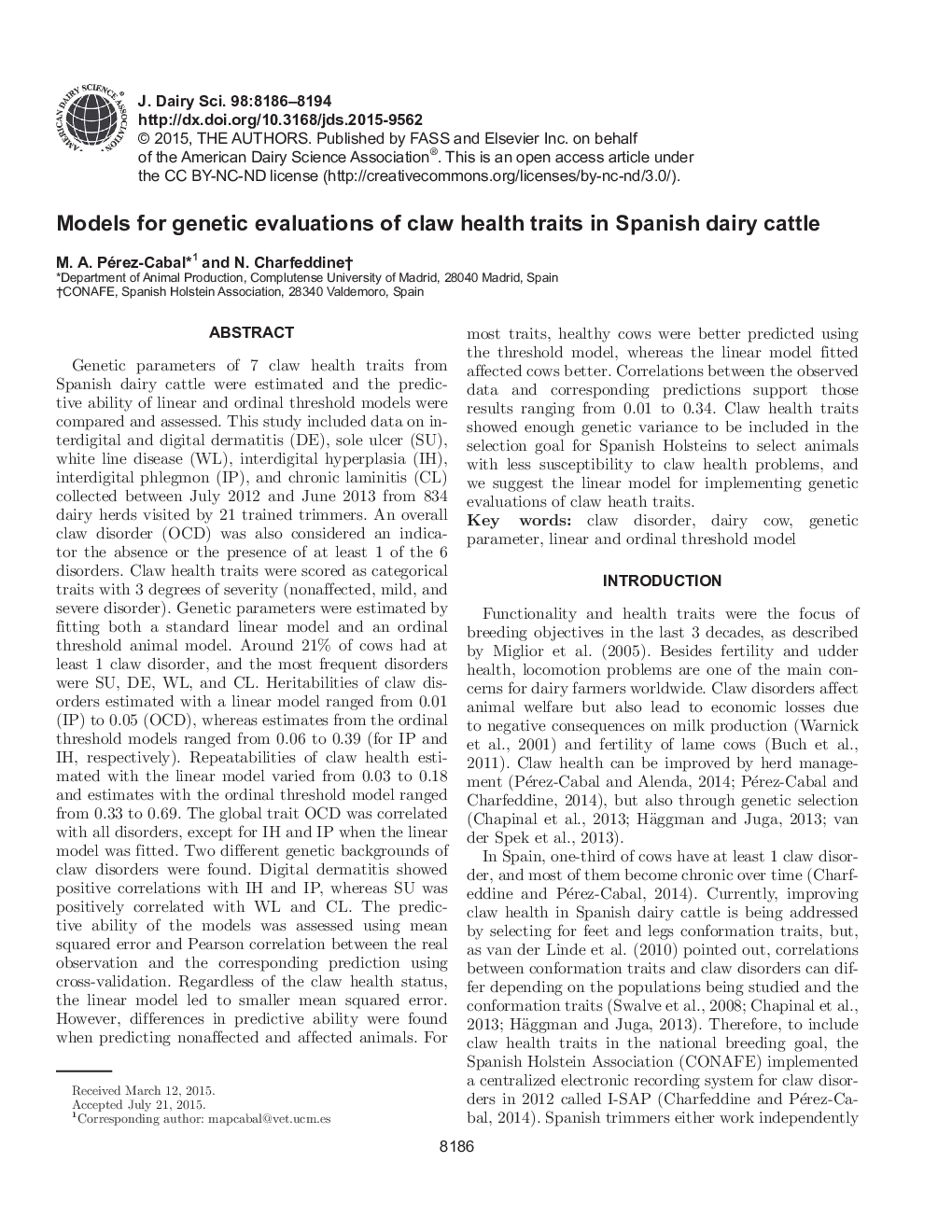| کد مقاله | کد نشریه | سال انتشار | مقاله انگلیسی | نسخه تمام متن |
|---|---|---|---|---|
| 10974590 | 1108026 | 2015 | 9 صفحه PDF | دانلود رایگان |
عنوان انگلیسی مقاله ISI
Models for genetic evaluations of claw health traits in Spanish dairy cattle
ترجمه فارسی عنوان
مدلهای ارزیابی ژنتیکی صفات سلامتی پستان در گاوهای شیری اسپانیا
دانلود مقاله + سفارش ترجمه
دانلود مقاله ISI انگلیسی
رایگان برای ایرانیان
کلمات کلیدی
اختلال پستان، گاو شیری، پارامتر ژنتیکی، مدل آستانه خطی و مرتب،
موضوعات مرتبط
علوم زیستی و بیوفناوری
علوم کشاورزی و بیولوژیک
علوم دامی و جانورشناسی
چکیده انگلیسی
Genetic parameters of 7 claw health traits from Spanish dairy cattle were estimated and the predictive ability of linear and ordinal threshold models were compared and assessed. This study included data on interdigital and digital dermatitis (DE), sole ulcer (SU), white line disease (WL), interdigital hyperplasia (IH), interdigital phlegmon (IP), and chronic laminitis (CL) collected between July 2012 and June 2013 from 834 dairy herds visited by 21 trained trimmers. An overall claw disorder (OCD) was also considered an indicator the absence or the presence of at least 1 of the 6 disorders. Claw health traits were scored as categorical traits with 3 degrees of severity (nonaffected, mild, and severe disorder). Genetic parameters were estimated by fitting both a standard linear model and an ordinal threshold animal model. Around 21% of cows had at least 1 claw disorder, and the most frequent disorders were SU, DE, WL, and CL. Heritabilities of claw disorders estimated with a linear model ranged from 0.01 (IP) to 0.05 (OCD), whereas estimates from the ordinal threshold models ranged from 0.06 to 0.39 (for IP and IH, respectively). Repeatabilities of claw health estimated with the linear model varied from 0.03 to 0.18 and estimates with the ordinal threshold model ranged from 0.33 to 0.69. The global trait OCD was correlated with all disorders, except for IH and IP when the linear model was fitted. Two different genetic backgrounds of claw disorders were found. Digital dermatitis showed positive correlations with IH and IP, whereas SU was positively correlated with WL and CL. The predictive ability of the models was assessed using mean squared error and Pearson correlation between the real observation and the corresponding prediction using cross-validation. Regardless of the claw health status, the linear model led to smaller mean squared error. However, differences in predictive ability were found when predicting nonaffected and affected animals. For most traits, healthy cows were better predicted using the threshold model, whereas the linear model fitted affected cows better. Correlations between the observed data and corresponding predictions support those results ranging from 0.01 to 0.34. Claw health traits showed enough genetic variance to be included in the selection goal for Spanish Holsteins to select animals with less susceptibility to claw health problems, and we suggest the linear model for implementing genetic evaluations of claw heath traits.
ناشر
Database: Elsevier - ScienceDirect (ساینس دایرکت)
Journal: Journal of Dairy Science - Volume 98, Issue 11, November 2015, Pages 8186-8194
Journal: Journal of Dairy Science - Volume 98, Issue 11, November 2015, Pages 8186-8194
نویسندگان
M.A. Pérez-Cabal, N. Charfeddine,
